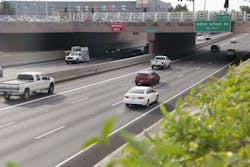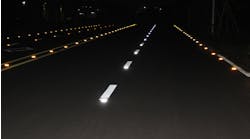One thing may generate the highest level of concern among freeway drivers and highway safety engineers across the country.
No, not excessive speeders or aggressive drivers traveling in the correct direction (although they are definitely high on the list). Instead, the thought of encountering a wrong-way driver—often during overnight hours—is very scary for those driving the right way, as well as for law enforcement agencies and other first responders.
The Arizona Department of Transportation (ADOT) has taken on the challenge of reducing the risks posed by wrong-way drivers by testing and expanding the use of technological countermeasures on Phoenix-area freeways.
After the successful deployment of its first-in-the-nation wrong-way vehicle detection and notification system along a busy stretch of I-17 in Phoenix, ADOT is expanding the use of key components of that thermal camera-based project to other freeways in the Valley of the Sun.
The major components of the $4 million I-17 system are thermal detection cameras and a computerized decision support system that provide immediate alerts to ADOT’s Traffic Operations Center in Phoenix as well as the state Department of Public Safety (DPS) and its highway patrol.
“Our analysis of the I-17 system and its ability to successfully detect wrong-way drivers as they make a turn onto an off-ramp backed the decision to use the thermal cameras on additional freeways,” said Dallas Hammit, ADOT’s state engineer and deputy director for transportation. “In fact, we didn’t have to wait for the analysis to be completed before expanding the use of the detection cameras at other freeway interchanges. We were sold on their reliability.”
That includes cameras now in place on stretches of the Loop 101 Price Freeway in the Chandler area, Loop 303 north of I-10 in Goodyear, and the new Loop 202 South Mountain Freeway in Phoenix.
The agency’s primary goals in deploying the detection and warning technology include providing instant alerts to the highway patrol, allowing troopers to respond much faster than waiting for 911 calls from other freeway drivers. The fast alerts also allow dispatchers in ADOT’s operations center to quickly post warning messages on digital signs for right-way freeway drivers to see in areas where a detection occurs.
“The thermal camera detections and alerts reduced response times for DPS,” said Brent Cain, who leads ADOT’s Transportation Systems Management and Operations division. “On I-17, fortunately most of the drivers whose wrong-way vehicles were detected turned around on a ramp without entering the freeway’s mainline lanes. We’ve also registered wrong-way incidents where troopers were able to stop a driver before a crash occurred. Our efforts are focused on reducing the risks presented by wrong-way drivers.”
Since it was installed in January 2018, ADOT’s I-17 system has detected more than 250 wrong-way vehicles on exit ramps or other locations being monitored, including mainline freeway lanes. In all, there are 90 thermal cameras in use, primarily at interchanges, as part of the pilot project set up along a 15-mile stretch of the freeway in Phoenix.
ADOT is working with the Maricopa Association of Governments, which plans freeways as the Phoenix area’s metropolitan planning organization, in scheduling expansion of the network of thermal cameras for wrong-way vehicle detection as future funding allows.
Thermal camera installation was made part of the budgets of recent construction projects to add new lanes to stretches of Loop 101. And for the first time, ADOT will soon be installing thermal cameras on electronic message signs to establish wrong-way vehicle detection along a part of the Loop 101 Agua Fria Freeway in the Glendale area, west of Phoenix.
“This provides us with another option for alerting us, and law enforcement, to wrong-way vehicles,” said Cain. “While the initial focus of using this thermal technology has been on the busier urban freeways in the Phoenix area, we’re also planning for the use of detection cameras in rural areas. Our network of message signs across the state provide an option for where a number of them could be located.”
The decision to use thermal cameras to spot wrong-way drivers occurred during ADOT’s research into potential countermeasures in 2017. While checking on sensor and radar-based systems, staff also noted that thermal cameras primarily used for traffic-signal sequencing at freeway interchanges also could be used to establish “inverse direction” arrays when directed toward the lanes of an exit ramp or other section of roadway.
That led to the development of ADOT’s pilot system that’s now in place on I-17 in Phoenix. The project also has been testing specialized background-illuminated “Wrong Way” signs along off-ramps that automatically activate when a thermal-camera detection occurs. Those signs, designed to increase the chances of getting the attention of the wrong-way driver, include flashing red LED warning lights. The agency plans to use those signs at other freeway locations as funding becomes available.
ADOT’s wrong-way vehicle countermeasure efforts have gained notice outside of Arizona. Agency officials have discussed their thermal camera experience with counterparts from other states. The I-17 alert system, along with a program to station highway patrol troopers in the state’s traffic operations center to enhance communication, were honored in 2018 by the National Operations Center of Excellence. The system also has been recognized with other awards for innovation.
“We understand that thermal cameras, flashing signs, and other technology can’t stop someone who’s impaired from getting behind the wheel and becoming a wrong-way driver,” said ADOT’s Hammit. “The cameras can’t physically stop a tragic crash from happening. But they can reduce the risks faced by drivers who are traveling the right way, especially in the middle of the night. It could come down to the seconds saved when a trooper or troopers are able to respond to an alert. Or if freeway drivers see a warning message, posted very quickly, that tells them a wrong-way driver may be up ahead. It’s definitely worth it to know that this technology played a role in some incidents where crashes didn’t happen."
Click here for ADOT's Report on the I-17 Wrong-Way Vehicle Alert System.



